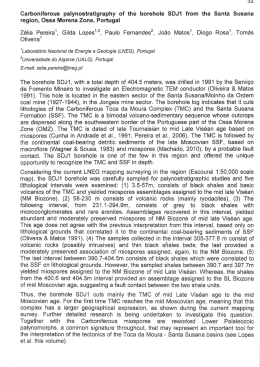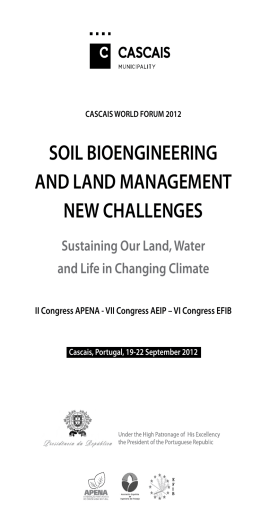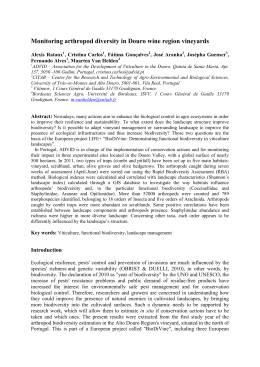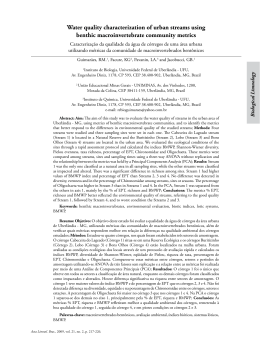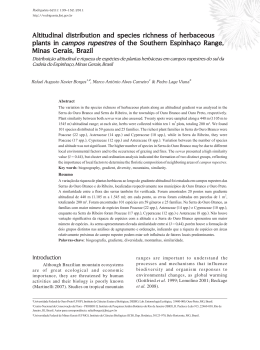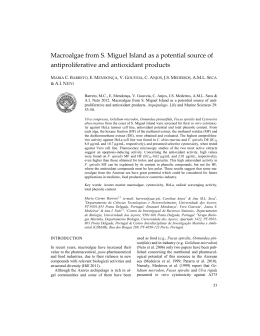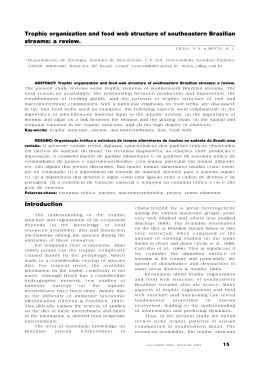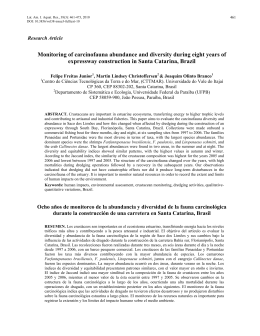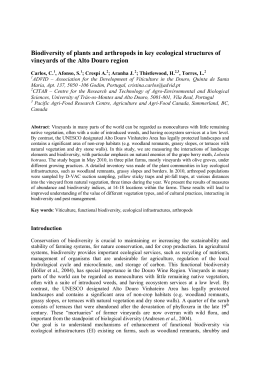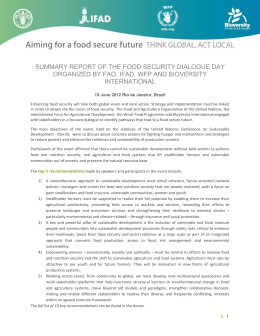Limnetica, 29 (2): x-xx (2011) Limnetica, 32 (2): 287-302 (2013) c Asociación Ibérica de Limnología, Madrid. Spain. ISSN: 0213-8409 The influence of landscape on the spatial and temporal distribution of stream macroalgal communities of two types of subtropical biomes Régis de C. Oliveira1,∗ , Aurélio F. Tonetto1 , Cleto K. Peres2 and Ciro C. Z. Branco1 1 São Paulo State University, UNESP, Department of Biological Sciences, Av. Dom Antônio, 2100, 19806-900, Assis, SP, Brazil. 2 Federal University of Latin-American Integration, UNILA, Av. Tancredo Neves, 6731, 85867-970, Foz do Iguacu, PR, Brazil. ∗ 2 Corresponding author: [email protected] Received: 26/11/12 Accepted: 4/9/13 ABSTRACT The influence of landscape on the spatial and temporal distribution of stream macroalgal communities of two types of subtropical biomes Landscape properties must be considered in the interpretation of ecological patterns of stream macroalgal communities. In this study, we sampled streams with different types of riparian cover from two biomes (highland grassland, HG, and seasonal semideciduous forest, SSF) for a period of one year. Each stream was visited four times, once in each season, during which we observed the algal growth and recorded measurements of a set of physical and chemical properties. Nineteen macroalgal taxa were recorded for HG, while 21 were recorded for SSF, but only three species were common to both biomes. Student’s t-test results showed that significant differences existed between HG and SSF only for stream depth for abiotic variables and for abundance for biotic variables, while the results of a detrended correspondence analysis (DCA) revealed that the taxonomic compositions were sharply different at the landscape level. In addition, the DCA results showed that when each landscape was considered individually, the HG macroalgal communities had a clear spatial structure, while for SSF macroalgal communities no spatial structure was detected. These results suggest that although the taxonomic richness of HG and SSF are relatively similar, the landscape conditions of each biome, mainly riparian cover types, could be relevant in the determination of quantitative and qualitative differences in the stream macroalgal communities both between and within biomes. Key words: Aquatic vegetation, subtropical biome, lotic systems, stream algae, South America. RESUMEN La influencia del paisaje en la distribución espacial y temporal de las comunidades de macroalgas en arroyos de dos tipos de biomas subtropicales Las propiedades del paisaje deben ser consideradas en la interpretación de los patrones ecológicos de las comunidades de macroalgas en arroyos. En este estudio, se tomaron muestras de arroyos con una cobertura de ribera diferente situados en dos biomas (campos de montaña, HG y el bosque semideciduo estacional, SSF) por un período de un año. Cada arroyo fue visitado cuatro veces, una vez en cada estación del año, cuando se observó el crecimiento de las algas, y se registraron una serie de datos sobre sus características físicas y químicas. Diecinueve taxones de macroalgas fueron registrados para HG, mientras que 21 para SSF, pero sólo tres especies fueron comunes a ambos paisajes. La prueba t de Student mostró diferencias entre HG y SSF sólo en la profundidad de los ríos, para las variables abióticas, y en la abundancia para las variables bióticas, mientras DCA reveló que la composición taxonómica fue marcadamente diferente en función del paisaje. Además, la DCA demostró que, cuando se considera individualmente cada paisaje, las comunidades de macroalgas de HG tienen una estructura espacial clara, mientras que para SSF no se observó ninguna estructura espacial. Estos resultados sugieren que a pesar de que la riqueza taxonómica de HG y SSF sea relativamente similar, las condiciones paisajísticas de cada bioma, principalmente el tipo de cobertura de ribera, podrían ser relevantes en la determinación de las diferencias cuantitativas y cualitativas de las comunidades de macroalgas corriente inter y entre los biomas. Palabras clave: Vegetación acuática, bioma subtropical, sistemas lóticos, macroalgas fluviales, Sudamérica. 14974 Limnetica 32(2), pàgina 287, 26/11/2013 288 Oliveira et al. INTRODUCTION Lotic macroalgae have been widely described as being among the major primary producers that support higher trophic levels in rivers and streams (Stevenson et al., 1996). Important studies of stream macroalgal communities have been conducted in boreal, temperate, and tropical regions of various continents (e.g., BojorgeGarcía et al., 2010; Branco et al., 2009; Branco & Necchi, 1996; Hu & Xie, 2006; Krupek et al., 2007; McClintic et al., 2003; Necchi et al., 1995; 2000; Peres et al., 2009; Sherwood et al., 2000). The results of these studies have suggested that the structure of stream macroalgal communities may change in response to the spatial and temporal variations of local environmental factors (e.g., temperature, dissolved oxygen, and current velocity). However, properties that determine the heterogeneity and dynamics of streams can be strongly influenced by many landscape factors (Hughes & Hunsaker, 2002; Wang et al., 2003; 2006; Allan, 2004), highlighting the importance of these attributes in ecological studies on lotic organisms. The landscape approach allows an ecological evaluation, from a truly holistic per- spective, of the relationships between organisms and their environment on multiple scales in space and time (Tockner et al., 2002; Wiens, 2002). This approach, although traditionally applied to land, can be very useful in the evaluation of aquatic systems. Differences in the structures of macroalgae communities among streams with distinct levels of riparian vegetation in tropical regions have been previously suggested. Riparian vegetation is important in the regulation of several stream characteristics (e.g., light availability and water temperature) and processes (e.g., seasonal habitats) that can influence the spatial and temporal distribution of macroalgae (Wang et al., 2006). For instance, Necchi et al. (2008) showed that in open streams, macroalgal communities have higher richness and abundance than in shaded ones. However, ecological studies of macroalgal communities in streams with different types of riparian vegetation have not been carried out using the landscape approach. This approach differs from that taken in previous studies that have focused on the ecological distribution of stream macroalgal communities in that it allows the evaluation of the effect of the environment Figure 1. Locations of biomes studied. Ubicación de los biomas estudiados. 14974 Limnetica 32(2), pàgina 288, 26/11/2013 The influence of biome type on the distribution of stream macroalgae as a whole, as opposed to consideration of particular local abiotic factors only. In this context, landscape features (riparian vegetation cover) were used in this study to compare taxonomic composition, species richness and abundance of macroalgal communities in streams with different types of riparian cover located in two distinct biomes, highland grassland (HG) and seasonal semideciduous forest (SSF), by season. As previous studies have found differences in the distribution of macroalgae communities in streams with different riparian vegetation (e.g., Branco et al., 2009; Necchi, 2004; Sheath & Burkholder, 1985), our hypotheses were that richness, abundance and diversity should be higher in the non-forested biome (HG) than in streams from the forested one (SSF) and that the taxonomic composition should be different between these distinct landscapes. MATERIALS AND METHODS Study areas The highland grassland area (HG), a non-forested biome, sampled during the study period was the Vila Velha State Park (VVSP), a protected unit located in Paraná State in southern Brazil, covering an area of 31.22 km2 (Fig. 1). The region has a humid subtropical climate, characterised by well-distributed rainfall, a moderate summer and a severe winter (IAP, 2004). The VVSP is located in a sedimentary basin in the second plateau of Paraná, in a region strongly affected by faults, fractures and dikes related to Mesozoic activity (Melo et al., 2004). The geological units present in the VVSP are the Furnas and Ponta Grossa formations (Devonian), the Itararé Group (Carboniferous–Permian), Serra Geral diabase dikes (Lower Cretaceous) and Quaternary alluvial and colluvial sediments (Melo et al., 2004). The topography of the region is formed by rolling hills, alternating peaks with valley floors, without tabular features. The shading level in the VVSP sampling sites was estimated using the procedures described by Denicola et al. (1992), and they all fit within the categories “open” or 14974 Limnetica 32(2), pàgina 289, 26/11/2013 289 “partly shaded,” which means that the sparse riparian vegetation allows total availability of sunlight to organisms at the bottoms of streams. The forested biome sampled was a seasonal semideciduous forest (SSF) in the Iguaçu National Park (INP), a protected unit located in Paraná State in southern Brazil, covering an area of approximately 1,850 km2 (Fig. 1). The region has a mild mesothermal humid climate without a defined dry season (Salamuni et al., 2002). The INP is situated in the third plateau of Paraná, a volcanic basaltic region, and the topography is formed by gently rolling hills with a predominance of tabular forms. The shading levels of the INP sampling sites were categorised as “shaded” or “heavily shaded.” This means that the strong arboreal riparian vegetation limits the availability of light to organisms at the bottoms of streams. A previous study (Branco et al., unpublished data) reported very low concentration of total nitrogen and total phosphorus in streams in the VVSP and INP, indicating that these environments are oligotrophic. In addition, the headwaters of all streams in both landscapes sampled in the present study are located within protected units, so that very little anthropic impact was observed. Sampling procedures We sampled five streams in each landscape, totalling 10 sampling sites. At all of the sampling sites, the only macroscopic primary producer found was macroalgae, despite some macrophytes (mainly aquatic bryophytes) being observed in occasional samplings. The investigation was conducted in 2009. When each stream was visited four times, once in each season (fall, winter, spring and summer). We analysed the growth of macroalgae and collected physical and chemical characteristics of each stream. During each sampling visit, 10 m of a stream segment was checked for the richness and abundance (per cent cover) of macroalgal species, following the cross-transect technique (Branco et al., 2008). The specimens collected were preserved in a 4 % formaldehyde solution (Branco et al., 2008). We 290 Oliveira et al. nostidis & Komárek, 1988, 1990; Komárek & Anagnostidis, 1986, 1989, 2005). adopted the concept of macroalgae defined by Sheath & Cole (1992). In addition to the macroalgal data, water temperature, turbidity, specific conductance, pH and dissolved oxygen were measured at the midpoint of the stream segment using a water analyser (HORIBA U-10). The current velocity and depth were measured using a mechanical flow meter (General Oceanics 2030R) and a ruler, respectively. In the laboratory, we identified the species by microscopic observations and morphometric analysis of the collected specimens using a Leica DM1000 trinocular microscope and a Leica DFC 280 image capture digital camera system coupled to a computer. The morphometric analyses required for species identifications were made using the image analysis software Leica IM-50. The macroalgal specimens were identified to the species level whenever possible, using taxonomic references specific to Brazilian material (e.g., Branco et al., 2008, 2009; Necchi et al., 1995, 2000, 2008). The classification of taxa into divisions and families followed Hoek et al. (1995), except for Cyanobacteria (Anag- Data analyses The data on physical and chemical features and macroalgal species (richness and abundance) were subjected to a one-way analysis of variance (ANOVA) to identify possible spatial and temporal differences among the streams in each landscape. Student’s t-test was applied to compare the biomes analysed. Both tests were carried out using BioEstat 5.0 (Ayres et al., 2007). For each sampling site, we calculated the Shannon–Wiener diversity index using the equation H = Σ(pi ∗ log10 pi ), where pi = proportion (abundance = per cent cover) of species i within a community. The species per cent cover was used to create dominance–diversity curves to compare the dominant species among the sites and seasons for both landscapes (Wilson, 1991). For HG and SSF together, a detrended correspondence analysis (DCA) based on the species composition was used. These analyses were per- Table 1. Values of the physical and chemical variables measured (minimum, maximum, mean and standard deviation) for each biome sampled (highland grassland = HG and seasonal semideciduous forest = SSF). Valores de las variables físicas y químicas (mínimo, máxima, media y desviación estándar) para cada bioma muestreado (campos de montaña/HG y bosque semideciduo estacional/SSF). Fall Winter Spring Summer HG SSF HG SSF HG SSF HG SSF Temperature ( C) 16.5-18.5 17.4 ± 0.7 19.2-20.7 19.7 ± 0.6 15.2-19.4 17.1 ± 1.6 17-20.2 19.0 ± 1.2 21-25.1 22.5 ± 1.7 21-22.5 21.8 ± 0.7 18.5-21.3 19.8 ± 1.0 17.5-21.3 19.3 ± 1.8 Dissolved oxygen (mg · L−1 ) 4.4-6.7 5.9 ± 0.9 5.6-6.9 6.2± 0.5 5-7.6 6.6 ± 1.0 6.7-7.6 7.0 ± 0.3 4.9-6.2 5.8 ± 0.5 4.5-6.3 5.4 ± 0.8 4.7-5.9 5.5 ± 0.5 5.7-6.4 5.9 ± 0.3 pH 5.1-7.1 6 ± 0.7 3.2-7.8 6.4 ± 1.9 4.8-6.8 5.4 ± 0.8 6.8-7.2 6.9 ± 0.2 6.4-7.8 6.9 ± 0.5 5.2-6.9 6.1 ± 0.6 5.9-7.8 6.6 ± 0.7 6.2-7.8 7.2 ± 0.6 5-49 20.8 ± 19.9 13-43 29.4 ± 11.8 5-68 23.2 ± 26.5 20-36 28.8 ± 6.6 3-46 13-250 3-59 13.4 ± 18.3 99.4 ± 116.0 16.2 ± 24.0 15-37 28 ± 8.3 2-13 6.6 ± 5.0 5-11 6.8 ± 2.4 1-9 5.2 ± 3.2 2-13 6.4 ± 4.0 7-30 14.2 ± 9.0 43-246 112.8 ± 82.4 5-12 7.0 ± 2.9 2-14 6.4 ± 4.9 7.8-24.1 17.8 ± 6.5 11.7-45.4 26.0 ± 14.3 3.5-12.4 9 ± 3.3 11-27.8 18.3 ± 8.1 6.9-18.1 12.8 ± 5.0 24.4-60.9 43.8 ± 18.3 10.3-24 15.6 ± 6.0 7.5-29.4 16.7 ± 9.5 38.9-112.8 70.6 ± 28.8 34.5-106.9 57.1 ± 29.7 15.2-89.4 39.3 ± 29.6 24.3-106.5 51.8 ± 37.7 44.5-106.4 82.5-157.4 78.7 ± 25.7 108.1 ± 30.0 37.6-91.1 63.7± 20.1 14.9-83.8 39.5 ± 31.1 ◦ Specific conductance (µS · cm−1 ) Turbidity (NTU) Depth (cm) Current velocity (cm · s−1 ) 14974 Limnetica 32(2), pàgina 290, 26/11/2013 The influence of biome type on the distribution of stream macroalgae formed using the software PC-ORD for Windows version 4.1 (McCune & Mefford 1999). RESULTS Environmental variables The abiotic data from both landscapes are summarised in Table 1. The comparison of environmental variables between the two landscapes showed a significant difference only for stream depth (t = −24.718, p < 0.05), with higher values in SSF than in HG. There were no notable differences in any of the environmental characteristics between the two landscapes. For the HG streams, we recorded moderate water temperatures (15.2-25.1 ◦ C) and dissolved oxygen values (4.9-7.6 mg L−1 ), acid to slightly basic pH (5.8-7.3), variable current velocity (15.2-106.4 cm·s−1 ), low specific conductance (3-68 µS·cm−1 ), low turbidity (1-30 NTU) and shallow depths (3.5-24 cm). The ANOVA results for the five sites in HG indicated that significant differences existed between sites 1 and 2, 1 and 3, and 1 and 5 with respect to dissolved oxygen (F = 6.54, p < 0.001), between site 5 and all other sites with respect to specific conductance (F = 29.99, p < 0.001), between sites 3 and 1 and 3 and 4 with respect to depth (F = 4.81, p < 0.05), and between sites 4 and 5 with respect to current velocity (F = 3.61, p < 0.05). Significant differences by season were detected for temperature (F = 17.26, p < 0.001) and pH (F = 4.78, p < 0.05), with higher values observed in the spring and lower values observed in the winter for both variables. For the SSF streams, we recorded moderate water temperatures (17-22.5 ◦ C), moderate values of dissolved oxygen (4.5-7.6 mg.l−1 ), moderate pH (5.2-7.8), moderate to high values of specific conductance (13-250 µS·cm−1 ), and variable levels of turbidity (2-246 NTU), depth (7.560.9 cm), and current velocity (14.9-157.4 cm· ·s−1 ). The only significant difference detected was between the current velocities of sites 1 and 5 (F = 3.39, p < 0.05). The comparisons of seasonal values found the following significant 14974 Limnetica 32(2), pàgina 291, 26/11/2013 291 differences: the highest temperature (F = 5.28, p < 0.01), turbidity (F = 8.24, p < 0.001) and depth (F = 5.63, p < 0.001) were registered in the spring, the highest dissolved oxygen value was registered in the winter (F = 7.74, p < 0.001), and the lowest current velocity was registered in the summer (F = 4.37, p < 0.05). Macroalgal communities Highland Grassland Nineteen taxa were recorded in the HG streams (Table 2). Chlorophyta was the highest represented algal division (42 %), followed by Cyanobacteria (37 %) and Rhodophyta (21 %). Zygogonium sp. showed the highest frequency of occurrence among all taxa (45 % of the total samples), while nine other species (47 % of the total species) were found at only one sampling site (Table 2). With respect to the occurrence of species by season, seven species (37 %) were found in all seasons; six species (31.5 %) were found in three seasons, two species (10.5 %) were found in two seasons, and four species (21 %) were found in only one season. The abundance of macroalgal communities was relatively similar in all seasons, ranging from 3 to 25 % in the fall, 3 to 21 % in the winter, 2 to 28 % in the spring and 7 to 16 % in the summer. The richness of the macroalgal communities was relatively similar in all seasons, with 1 to 7 species recorded in the fall, 2 to 8 recorded in the winter and spring, and 2 to 5 recorded in the summer, although the highest richness at two of the five sites was recorded in the winter (Table 2). The ANOVA revealed no significant differences (p > 0.05) among the streams or the seasons with respect to richness (F = 0.09) or abundance (F = 0.22). In general, the Shannon– Wiener diversity index showed relatively low variation among the seasons (Table 2). The highest diversity values were observed in the fall and winter (with mean values of 0.33 and 0.32, respectively), and the lowest values were observed in the spring and summer (with mean values of 0.25 and 0.28, respectively) (Table 2). 14974 Limnetica 32(2), pàgina 292, 26/11/2013 3.8 5 6 0.2 1 7 3 5 4 1 0.38 0.42 0.46 0.36 0 0.33 3 1 0.8 0.1 2.5 2 0.7 2.7 3 Winter 17 3.8 0.9 4 0.2 6.1 5 8 5 2 3 2 0.63 0.45 0.21 0.27 0.04 0.32 6.9 1.2 1 1.2 4.1 1.7 5.1 0.7 0.1 1.3 4 19 2.9 0.3 6.3 0.4 3 0.3 0.7 2.7 2.1 2 1.7 0.2 0.1 0.1 0.6 0.5 1 Fall Species number corresponds to the figures. El número de las especies corresponde a las figuras. Cyanobacteria 1. Blennothrix komarekii Branco et Montejano 2. Nostoc verrucosum Vaucher ex Bornet et Flahault 3. Phormidium aerugineo-caeruleum (Gomont) Agnostidis et Komárek 4. Phormidium retzii (C. Agardh) Gomont ex Gomont 5. Symplocastrum friesii (C. Agardh) Forti 6. Scytonema arcangeli Bornet et Flahault 7. Stigonema robustum Gardner Chlorophyta 8. Closterium pusillum Hantzch var. pusillum 9. Cylindrocystis brebissonii Meneghini ex De Bary 10. Desmidium swartzii (C. Agardh) C. Agardh ex Ralfs var. swartzii f. punctata Irénée – Marie, Flor 11. Geminella interrupta 12. Microspora tumidula Hazen 13. Mougeotia sp. 14. Nitella leptostachys (A. Braun) R.D. Wood var. leptostachys 15. Zygogonium sp. Rhodophyta 16. Batrachospermum kerathophytum Bory emend. Sheath, Vis et Cole 17. Batrachospermum puiggarianum Grunow in Wittrock et Nordstedt 18. Batrachospermum sp. 19. Hildenbrandia angolensis Welwitsch ex W. West et G.S. West Species richness Seasonal diversity index (H log10 ) Mean value of diversity index Taxa 0.1 5.5 2 0.2 8.7 3 2.2 2.2 2.2 2.2 1 18 0.4 4 0.3 1.7 5 4 2 2 7 2 0.49 0.03 0.03 0.51 0.16 0.25 8.4 11.2 2 2 1 Spring 0.1 0.9 8.5 2 0.1 0.4 8.5 0.6 3 2.3 0.3 2.7 0.3 4 0.1 8.7 5 5 3 4 4 2 0.55 0.21 0.18 0.44 0.01 0.28 2.6 4 8.6 0.9 0.9 1 Summer Table 2. Richness and abundance of species and diversity index (H ) distributed seasonally in the highland grassland (HG). Riqueza y abundancia de especies e índice de diversidad (H ) distribuidos por estaciones en campos de montaña (HG). 292 Oliveira et al. Fall 14974 Limnetica 32(2), pàgina 293, 26/11/2013 1.7 3 0.24 0.1 0.4 Winter 1 0 0.1 0.5 0.5 2 0.4 0.1 1 0.4 0.2 8 4 4 0.55 0.55 0.31 0.33 1.6 4.8 0.1 0.1 0.1 0.1 1.6 1.1 Species number corresponds to the figures. El número de las especies corresponde a las figuras. Cyanobacteria 1. Chroococcopsis fluviatilis (Lagerheim) Komárek & Anagnostidis 2. Geitlerinema splendidum (Gomont) Anagnostidis 0.2 3. Microcoleus subtorulosus Gomont 0.2 4. Phormidium retzii (C. Agardh) Gomont ex Gomont 0.1 Chlorophyta 5. Basicladia emedii Peres & Branco 0.1 6. Chaetophora pisiformis (Roth) C.A.Agardh 7. Cladophora glomerata (Linnaeus) Kützing 8. Ecballocystis pulvinata var. pulvinata Bohlin 9. Microspora stagnorum (Kützing) Lagerheim 10.Oedogonium sp. 11. Spirogyra sp. Heterokontophyta 12. Terpsinoë musica Ehrenberg var. musica 0.1 13.Vaucheria sp. 0.2 Rhodophyta 14.Batrachospermum helminthosum Bory 15. Batrachospermum puiggarianum Grunow in Wittrock et Nordstedt 16. Batrachospermum sp.1 0.3 17. Batrachospermum sp. 2 18. Kumanoa abilii (Reis) Necchi Júnior & Vis 19. Kumanoa ambigua (Montagne) Entwisle M.L. Vis, W.B.Chiasson, Necchi Júnior & A. R. Sherwood 20. Hildenbrandia angolensis Welwitsch ex W. West et 1.5 G.S. West 21. “Chantransia” pygmaea 1.6 0.1 0.1 1.3 0.5 Species richness 3 1 5 2 2 0.38 0 0.64 0.07 0.2 Seasonal diversity index (H log10 ) Mean value of diversity index 0.26 Taxa 0.1 0.1 0.2 0.2 0.6 2 3 0 3 0.3 0.41 - 0.37 0.27 0.1 0.1 0.2 Spring 1 0 0.1 0.1 6 0.56 1 0 0.2 0.2 0.2 0.1 0.3 0.1 0.7 0.3 0.1 0.4 1.2 0.2 3 2 3 0.23 0.28 0.36 0.29 8.6 1.4 Summer Table 3. Richness and abundance of species and diversity index (H ) distributed seasonally in the semideciduous season forest (SSF). Riqueza y abundancia de especies e índice de diversidad (H ) distribuidos por estaciones en el bosque semideciduo estacional (SSF). The influence of biome type on the distribution of stream macroalgae 293 294 Oliveira et al. Figure 2. Dominance–diversity curves for HG, based on the percentage abundance of macroalgae by site (S) and season (F = fall, W = winter, SP = spring, SU = summer). The numbers presented in the graphs correspond to the species reported in table 2. Curvas dominancia-diversidad de HG basado en el porcentaje de abundancia de macroalgas en los lugares de muestreo (S) y las estaciones (F = otoño, W = invierno, SP = primavera, SU = verano). Los números del gráfico corresponden a las especies de la tabla 2. Dominance–diversity curves showed that Zygogonium sp. was the dominant species at sites 1 and 4, Stigonema robustum was the dominant species at sites 2 and 3, and Blennothrix komarekii was the dominant species at site 5 (Fig. 2). The dominant species at each site were relatively consistent throughout the samplings, with minor changes from season to season (Fig. 2). According to the dominance–diversity 14974 Limnetica 32(2), pàgina 294, 26/11/2013 curves, the highest evenness was found at site 2, and the lowest was found at site 5 (Fig. 2). For the individual sampling sites, no consistent pattern was observed for evenness in all seasons; however, the dominance–diversity curves showed higher dominance in the fall and lower dominance in the spring and summer at sites 1, 4 and 5 (Fig. 2). At site 1, the lowest evenness and the highest total richness were found in the fall The influence of biome type on the distribution of stream macroalgae and winter, respectively. Zygogonium sp. was dominant in all seasons, except in the winter, when the dominant species was Batrachospermum puiggarianum. Site 2 had higher richness and evenness during the winter. Stigonema robustum was the only species found in all samples and was dominant in the fall and summer. At site 3, the highest richness and evenness were observed in the fall. Stigonema robustum was the dominant species in all seasons. Site 4 had the highest richness and evenness in the spring, with Zygogonium sp. being dominant in the fall and winter and Closterium pusillum being dominant in the spring and summer. At site 5, only two 295 species were found, with Blennothrix komarekii being dominant in all seasons and the highest evenness occurring in the summer. Seasonal Semideciduous Forest Twenty-one taxa were found in the SSF streams (Table 3), including representatives of Rhodophyta (38.1 %), Chlorophyta (33.3 %), Cyanobacteria (19.1 %), and Heterokonthophyta (9.5 %). The stage “Chantransia” pygmaea of Batrachospermum (Pueschel et al., 2000) was the taxon with the highest frequency of occurrence (75 % of the total samples) and was the only Figure 3. Dominance–diversity curves for SSF, based on the percentage abundance of macroalgae by site (S) and season (F = fall, W = winter, SP = spring, SU = summer). The numbers presented in the graphs correspond to the species reported in table 3. Curvas dominancia-diversidad de SSF basado en el porcentaje de abundancia de macroalgas en los lugares de muestreo (S) y las estaciones (F = otoño, W = invierno, SP = primavera, SU = verano). Los números del gráfico corresponden a las especies de la tabla 3. 14974 Limnetica 32(2), pàgina 295, 26/11/2013 296 Oliveira et al. taxon found in all seasons and at all sites. The majority of the species were restricted in their occurrence, with fifteen species (72 % of the total species) registered at a single sampling site. In relation to the seasonal occurrence, 10 species (48 %) were found in only one season (Table 3). In general, the abundance of macroalgal communities was low at all sites and in all seasons, ranging from 0 to 4 % in the fall, 1 to 9 % in the winter, 0 to 1 % in the spring and 0 to 10 % in the summer. The richness of macroalgal communities ranged from 1 to 5 species in the fall, 1 to 8 species in the winter, 0 to 3 species in the spring and 1 to 6 species in the summer, but the highest values for three of the five sites were recorded in the winter (Table 3). The ANOVA results revealed no significant differences (p > 0.05) by season for richness (F = 1.195) or abundance (F = 1.291). In general, the Shannon–Wiener diversity index values varied relatively little from season to season. The highest seasonal diversity index corresponded to the winter and the lowest corresponded to the fall (mean values of 0.33 and 0.26, respectively; see Table 3). The dominance–diversity curves showed that “Chantransia” pygmaea was dominant at sites 1 and 4, Phormidium retzii was dominant at site 2, Vaucheria sp. was dominant at site 3, and Batrachospermum sp. was dominant at site 5. In general, the dominant species at each site varied by season (Fig. 3). The evenness, indicated by the slope of the dominance–diversity curve, was relatively high in all sites. We observed a seasonal tendency for higher evenness in the spring (at sites 1, 2 and 4). Site 1 had the highest evenness and richness in the spring and winter, respectively. “Chantransia” pygmaea was dominant in the fall and winter, while Hildenbrandia angolensis was dominant in the spring and summer. At site 2, we observed the occurrence of a few species in all seasons, and more than one taxon was recorded only in spring (three taxa). Site 3 had higher evenness and richness in the fall and winter than in the spring and summer. In addition, site 3 had a distinct dominant taxon in each season. At site 4, the evenness was similar for all seasons except fall, when the dominance of “Chantransia” pygmaea was observed. Site 5 14974 Limnetica 32(2), pàgina 296, 26/11/2013 had similar evenness in all seasons except the spring, when only one species was recorded. Comparative Analyses Among the 37 macroalgal species identified during the study, 21 (56.8 %) were found in SSF, 19 (51.4 %) in HG and only three (8.1 %) in both landscapes (Tables 2-3). Despite the similarity of richness values in HG and SSF, the average value of per cent cover was higher in HG than in SSF (x̄ = 11.2± 8.1 % and x̄ = 1.8 % ± 2.8, respectively) (Tables 2-3). The maximum value of per cent cover observed in HG was 28.2 %, while in SSF, it was 10.4 %. The average diversity index of macroalgal communities from HG (x̄ = 0.29±0.2) was very similar to that calculated for SSF (x̄ = 0.28 ± 0.21) (Tables 2-3). Student’s t-test comparisons of richness, per cent cover, and diversity index between the landscapes revealed a significant difference (t = 4.905, p < 0.001) only for per cent cover. The seasonal analysis showed similar variations in richness throughout the seasons for both landscapes, with higher values in the winter for SSF (x̄ = 4 ± 2.5) and in the winter and fall for HG (x̄ = 4 ± 2.5 and x̄ = 4 ± 2.3, respectively) (Tables 2-3). With respect to abundance, the mean values of per cent cover were much higher for HG than for SSF in all seasons (Tables 2-3). For HG, higher per cent cover values of macroalgal communities were observed in the spring (x̄ = 13.6±11.6) and winter (x̄ = 11.3±8), while for SSF, higher values were observed in the winter (x̄ = 3.2 ± 3). The seasonal variation in the diversity index values followed the same pattern as richness in both landscapes, with higher values in the winter for SSF (x̄ = 0.33 ± 0.2) and higher values in the fall and winter for HG (x̄ = 0.33 ± 0.2 and x̄ = 0.32 ± 0.2, respectively) (Tables 2-3). Comparisons of richness, per cent cover, and diversity index between the two landscapes by season revealed significant differences (p < 0.05) for per cent cover in all seasons (fall-t = 2.34; winter-t = 2.13; spring-t = 2.58; summer-t = 2.34). The two first DCA axes accounted for 43.4 % of the variation in the macroalgal community The influence of biome type on the distribution of stream macroalgae composition, considering both the HG and SSF sampling sites. The DCA showed a clear separation between the HG sampling sites and the SSF sampling sites, confirming that the species compositions of these two landscapes are distinct (Fig. 4). In addition, the DCA results revealed that the HG sampling sites exhibited a tendency to be spatially grouped, while no clear spatial grouping trend was observed for SSF, either by sampling site or by season. DISCUSSION The hypothesis that richness, abundance, and diversity in HG streams would be higher than in SSF streams was partially corroborated by our analyses. The macroalgal species richness, species number per site and diversity index registered in HG were relatively similar to those recorded in SSF (Tables 2–3), but the t-test and DCA results revealed that the abundances and taxonomic compositions of the communities, respectively, of the two landscapes were sharply 297 different. Considering also that the t-test results only indicated a significant difference in stream depth between HG and SSF, the quantitative and qualitative differences observed for the macroalgal communities at the landscape level cannot be attributed to the physical and chemical characteristics of the streams. In this context, the results indicate that the intrinsic landscape features of the biomes, mainly the vegetation type, could be the environmental aspect most closely related to the observed differences in abundance and species composition between HG and SSF. The relationship between algal communities and landscape characteristics has been noted in other studies (McGregor et al. 2006). The differences between HG and SSF in abundance and taxonomic composition detected in this study may be due to the presence of a specific vegetation type in each landscape that could determine the differential availability of a particular macroalgal species and their propagules (amount and dispersion). In HG, the predominance of grasses on the landscape scale, amplified by the lower depths observed in the Figure 4. Detrended correspondence analysis (DCA) of the taxa sampled. Abbreviations are as defined for figures 2 and 3. Análisis de Correspondencias Sin Tendencia (DCA), de los taxones muestreados. Abreviaciones como en la figura 3. 14974 Limnetica 32(2), pàgina 297, 26/11/2013 298 Oliveira et al. streams of this biome, produced high availability of sunlight in stream bottoms in all catchment areas, allowing the establishment of macroalgal communities with higher abundance and with a dominance of algal groups specifically adapted to this light condition, particularly Chlorophyta (Denicola et al., 1992; Necchi, 2004; Tonetto et al. 2012). Green algae are frequently reported as dominant in conditions of bright sunlight. In southern central Alaska, the high diversity of green algae has been reported to be related to poorly developed riparian canopies (Sheath et al., 1986). The increase in irradiance caused by the falling leaves of riparian vegetation during the fall has been identified as one of the factors responsible for the high richness of macroalgae in woodland streams in temperate regions (Zalack et al., 2006). In addition, it is possible that species that are well adapted to HG conditions were able to produce more dispersal propagules and thereby occupy more lotic habitats throughout the studied area. The effect of landscape features on dispersal efficiency has been described previously for other groups (Boström et al., 2010; Veres et al., 2013). In SSF, the stream macroalgal communities also responded to the landscape conditions. However, the limited light penetration permitted by the strong canopy development typically observed in the area resulted in a community with very low abundance and dominated by algal groups well adapted to shady conditions, particularly Rhodophyta (Branco & Necchi, 1996; Necchi, 2004; Tonetto et al., 2012; Sheath & Cole, 1992). For each landscape individually, the DCA showed that the macroalgal communities of HG had a tendency to exhibit a spatial structure, with grouping based on the sampling sites, while for SSF, no spatial structure was observed, with the sampling sites spread without a clear pattern (Fig. 4). Considering these results, we propose that in the absence of limiting irradiance (as occurs in HG streams), local abiotic characteristics may become relevant to the stream macroalgal distribution, producing more evident spatial patterns. On the other hand, in areas where the canopy cover is well developed (as in SSF streams), the limited irradiance acts as a strong 14974 Limnetica 32(2), pàgina 298, 26/11/2013 primary environmental filter, so that variations in the local abiotic characteristics are not able to influence the spatial distribution of stream macroalgae. The seasonal variations in the richness, abundance and diversity index of the macroalgal communities in both landscapes were relatively similar, with higher values registered in the fall and winter than in the spring and summer. The only exception was for abundance in HG, with the highest value corresponding to the spring. These results are consistent with those of several studies that have shown a more pronounced development of macroalgal communities in the period from late fall to early spring (Branco & Necchi, 1997; Necchi & Pascoaloto, 1993). Although the two biomes exhibited similar seasonal patterns with respect to some aspects of the community structure, the analysis of taxonomic composition and the dominance–diversity curves revealed different patterns between HG and SSF by season. In HG, 74 % of the macroalgal species were observed in three or four seasons, and few changes in the dominant species were observed throughout the seasons at almost all sampling sites. On the other hand, in SSF, 67 % of the macroalgal species were observed in only one or two seasons, and major differences in the dominant species by season was observed. These results suggest that the landscape works as a primary environmental filter in the temporal distribution patterns of macroalgal communities. In this context, the low seasonal variation in the landscape features in HG, mainly the constant high light availability, allows the establishment of more stable macroalgal communities, as demonstrated by the maintenance of a significant portion of the species and the consistency of the dominant species throughout the seasons (Krupek et al., 2012; Necchi et al., 2008; Yang et al., 2009). In SSF, the high seasonal variation in taxonomic composition and dominant species can be attributed to the seasonal loss of some tree leaves, which typically occurs in this biome, causing seasonal variation in the light availability in both time and space (Zalack et al., 2006). In summary, our results show that landscape features have an influence on the spatial and temporal distribution patterns of the stream macroal- The influence of biome type on the distribution of stream macroalgae gal communities in highland grassland and seasonal semideciduous forest biomes. We recommend the consideration of the riparian landscape in future research to better understand the establishment, maintenance and distribution of stream macroalgae in tropical rivers. ACKNOWLEDGMENTS The authors would like to thank FAPESP (Proc. 2007/52608-1) for its financial support, CAPES for a doctoral scholarship to RCO (Proc. 1072/11), CNPq for a research scholarship to CCZB (Proc. 302354/2008-5), and ICMBio and the conservation units for granting permission to collect specimens and for providing logistical support during our field work. REFERENCES ALLAN, J. D. 2004. Landscape and riverscapes: the influence of land use on river ecosystems. Annual Reviews of Ecology, Evolution, and Systematics, 35: 257–284. ANAGNOSTIDIS, K. & J. KOMÁREK. 1988. Modern approach to the classification system of cyanophytes. 3. Oscillatoriales. Algological Studies, 50–53: 327–472. ANAGNOSTIDIS, K. & J. KOMÁREK. 1990. Modern approach to the classification system of cyanophytes. 3. Stigonematales. Algological Studies, 59: 1–73. AYRES, M., J. R. M. AYRES, D. L. AYRES & A. S. SANTOS. 2007. BioEstat 5.0. Aplicações Estatísticas nas Áreas das Ciências Biológicas e Médicas, Universidade Federal do Pará. PA. Brasil. BOJORGE-GARCÍA, M., J. CARMONA, Y. BELTRÁN, & M. CARTAJENA. 2010. Temporal and spatial distribution of macroalgal communities of mountain streams in Valle de Bravo Basin, central Mexico. Hydrobiologia, 641: 159–169. BRANCO, C. C. Z. & O. JR. NECCHI. 1996. Distribution of stream macroalgae in the eastern Atlantic Rainforest of São Paulo State, southeastern Brazil. Hydrobiologia. 333: 139–150. BRANCO, L. H. Z. & O. JR. NECCHI. 1997. Seasonality of macroalgae in three Tropical drainage basins in São Paulo State, southeastern Brazil. 14974 Limnetica 32(2), pàgina 299, 26/11/2013 299 Archiv Für Hydrobiologie, Stuttgart, 141 (1): 75–91. BRANCO, C. C. Z., R. A. KRUPEK & C. K. PERES. 2008. Seasonality of macroalgal communities in a subtropical drainage basin in Paraná State, Southern Brazil. Brazilian Journal of Biology, 68: 631– 637. BRANCO, C. C. Z., R. A. KRUPEK & C. K. PERES. 2009. Distribution of Stream Macroalgal Communities from the Mid-Western Region of Paraná State, Southern Brazil: Importance of Local Scale Variation. Brazilian Archives of Biology and Technology, 52 (2): 379–386. BOSTRÖM, C., A. TÖRNROOS & E. BONSDORFF. 2010. Invertebrate dispersal and habitat heterogeneity: expression of biological traits in a seagrass landscape. Journal of Experimental Marine Biology and Ecology. 390 (2): 106–117. DENICOLA, D. M., K. D. HOGLAND & S. C. ROEMER. 1992. Influence of canopy cover on spectral irradiance and periphyton assemblages in a prairie stream. Journal of the North American Benthological Society, 11: 391–404. HOEK, C. VAN DEN., D. G. MANN & H. M. JAHNS. 1995. Algae: an introduction to phycology. Cambrige University Press. Cambridge. UK. HU, B. F. & S. L. XIE. 2006. Effect of seasonality on distribution of macroalgae in a stream system (Xin‘an Spring) in Shanxi Province, North China. Journal of Integrative Plant Biology, 48: 889–896. HUGHES, R. M. & C. T. HUNSAKER. 2002. Effects of landscape change on aquatic biodiversity and biointegrity. In: Applying landscape ecology in biological conservation. K. J. Gutzwiller (ed.): 309– 329. Springer-Verlag, New York. USA. IAP -Instituto Ambiental do Paraná. 2004. Plano de Manejo Parque Estadual de Vila Velha. PR. Brasil. KOMÁREK, J. & K. ANAGNOSTIDIS. 1986. Modern approach to the classification system of cyanophytes. 2. Chroococcales. Algological Studies, 43: 157–226. KOMÁREK, J. & K. ANAGNOSTIDIS. 1989. Modern approach to the classification system of cyanophytes. 4. Nostocales. Algological Studies, 56: 247–345. KOMÁREK, J. & K. ANAGNOSTIDIS. 2005. Band 19/2: Cyanoprokaryota, part 2. Oscillatoriales. In: Süsswasserflora von Mitteleuropa. B. Büdel; G. Gärtner; L. Krienitz & M. Schagerl (eds.). Spektrum Akademischer Verlag. 300 Oliveira et al. KRUPEK, R. A., C. C. Z. BRANCO & C. K. PERES. 2007. Distribuição Ecológica das Comunidades de Macroalgas da Bacia de Drenagem do Rio das Pedras, Região Centro-Sul do Estado do Paraná, Sul do Brasil. Brazilian Journal of Botany, 30 (2): 173–182. KRUPEK, R. A., C. C. Z. BRANCO & C. K. PERES. 2012. Spatial variations at different observational scales and the seasonal distributions of stream macroalgae in a Brazilian subtropical region. Brazilian Journal of Botany, 35 (3): 249–257. MCCLINTIC, A. S., D. A. CASAMATTA & M. L. VIS. 2003. A survey of algae from montane cloud florest and alpine streams in Bolivia: macroalgae and associated microalgae. Nova Hedwigia, 76: 363–379. MCCUNE, B. & M. J. MEFFORD. 1999. Multivariate Analysis of Ecological Data. Glendem Beach: MjM Software. MCGREGOR, G. B., J. C. MARSHALL & M. C. THOMS. 2006. Spatial and temporal variation in algal-assemblage structure in isolated dryland river waterholes, Cooper Creek and Warrego River, Australia. Marine and Freshwater Research, 57 (4): 453–466. MELO, M. S., L. C. GODOY, P. M. MENEGUZZO & D. J. P. SILVA. 2004. A geologia no plano de manejo do Parque Estadual de Vila Velha, PR. Revista Brasileira de Geociências, 34: 561–570. NECCHI, O. JR. 2004. Light-related photosynthetic characteristics of lotic macroalgae. Hydrobiologia, 525: 139–155. NECCHI, J. O. & D, PASCOALOTO. 1993. Seasonal dynamics of macroalgal communities in the Preto River basin, São Paulo, southeastern Brazil. Archiv Für Hydrobiologie, Stuttgart, 129 (2): 231–252. NECCHI, O. JR., C. C. Z. BRANCO, R. C. G. SIMÕES & L. H. Z. BRANCO. 1995. Distribution of stream macroalgae in northwest region of São Paulo State, southeastern Brazil. Hydrobiologia, 299: 219–230. NECCHI, O. JR., C. C. Z. BRANCO & L. H. Z. BRANCO. 2000. Distribution of stream macroalgae in São Paulo State, southeastern Brazil. Algological Studies, Stuttgart, 97: 43–57. NECCHI, O. JR., L. H. Z. BRANCO & D. SPEZAMIGLIO. 2008. Distribuição ecológica de comunidades de macroalgas de ambientes lóticos do Parque Nacional de Itatiaia (MG, RJ), Brasil. Brazilian Journal of Botany, 31: 135–145. 14974 Limnetica 32(2), pàgina 300, 26/11/2013 PERES, C. K., C. C. Z. BRANCO & R. A. KRUPEK. 2009. Distribuição ambiental e temporal das comunidades de macroalgas de riachos da Serra da Prata, Estado do Paraná, Sul do Brasil. Brazilian Journal of Botany, 32 (4): 625–633. PUESCHEL, C. M., G. W SAUNDERS, & J. A. WEST. 2000. Affinities of the freshwater red alga Audouinella macrospora (Florideophyceae, Rhodophyta) and related forms based on SSU rDNA gene sequence and pit plug ultrastructure. Journal of Phycology, 36: 433–439. SALAMUNI, R., E. SALAMUNI, L. A. ROCHA & A. L. ROCHA. 2002. Parque Nacional do Iguaçu, PR-Cataratas de fama mundial. In: Sítios Geológicos e Paleontológicos do Brasil. Schobbenhaus, C., D. A. Campos, E. T. Queiroz, M. Winge & M. L. C. Berbert-Born (eds.): 313–321. Comissão Brasileira de Sítios Geológicos e Paleobiológicos. Brasil. SHEATH, R. G. & J. BURKHOLDER. 1985. Characteristics of softwater stream in Rhode Island. II: Composition and seasonal dynamics of macroalgae communities. Hydrobiologia, 128: 109–118. SHEATH, R. G. & K. M. COLE. 1992. Biogeography of stream macroalgae in North America. Journal of Phycology, 28: 448–460. SHEATH, R. G., M. O. MORISON, J. E. Korch, D. KACZMARCZYK & K. M. COLE. 1986. Distribution of stream macroalgae in south-central Alaska. Hydrobiologia, 135: 259–269. SHERWOOD, A. R., T. L. RINTOUL, K. M. MÜLLER & R. G. SHEATH. 2000. Seasonality of epilithic diatoms, macroalgae and macrophytes in a spring-fed stream system in Ontario, Canada. Hydrobiologia, 435: 143–152. STEVENSON, R. J., M. L. BOTHWELL & R. L. LOWE. 1996. Algal Ecology - Freshwater Benthic Ecosystems. Academic Press, San Diego. USA. TOCKNER, K., J. V. WARD, P. J. EDWARDS & J. KOLLMANN. 2002. Riverine landscape: an introduction. Freshwater Biology, 47: 497–500. TONETTO, A. F., C. C. Z. BRANCO & C. K. PERES. 2012. Effects of irradiance and spectral composition on the establishment of macroalgae in streams in southern Brazil. Annales de Limnologie-International Journal of Limnology, 48 (04): 363–370. VERES, A., S. PETIT, C. CONORD, & C. LAVIGNE. 2013. Does landscape composition affect pest abundance and their control by natural ene- The influence of biome type on the distribution of stream macroalgae mies? A review. Agriculture, Ecosystems & Environment, 166: 110–117. WANG, L., J. LYONS, P. RASMUSSEN, P. KANEHL, P. W. SEELBACH, T. SIMON, M. WILEY, E. BAKER, S. NIEMELA & M. STEWART. 2003. Influences of landscape and reach-scale habitat on stream fish communities in the Northern Lakes and Forest ecoregion. Canadian Journal of Fisheries and Aquatic Sciences, 60: 491–505. WANG, L., P. W. SEELBACH & R. M. HUGHES. 2006. Introduction to landscape influences on stream habitats and biological assemblages. American Fisheries Society Symposium, 48: 1–23. WIENS, J. A. 2002. Riverine landscape: taking land- 14974 Limnetica 32(2), pàgina 301, 26/11/2013 301 scape ecology into the water. Freshwater Biology, 47: 501–515. WILSON, J. B. 1991. Methods for fitting dominance/diversity curves. Journal of Vegetation Science, 2: 35–46. YANG, G. Y., T. TANG & D. DUDGEON. 2009. Spatial and seasonal variations in benthic algal assemblages in streams in monsoonal Hong Kong. Hydrobiologia, 632: 189–200. ZALACK, J. T., D. A. CASAMATTA, R. G. VERB & M. L. VIS. 2006. A Two-year Survey of the Algal Community in a Woodland Stream from Southeastern Ohio. Northeastern Naturalist, 13 (3): 301–318. 14974 Limnetica 32(2), pàgina 302, 26/11/2013
Download
